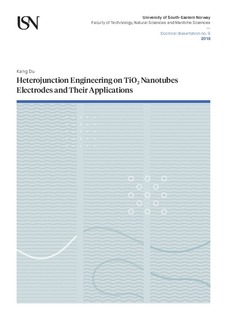| dc.contributor.advisor | Wang, Kaiying | |
| dc.contributor.advisor | Chen, Xuyuan | |
| dc.contributor.author | Du, Kang | |
| dc.date.accessioned | 2018-09-07T11:12:23Z | |
| dc.date.available | 2018-09-07T11:12:23Z | |
| dc.date.issued | 2018 | |
| dc.identifier.isbn | 978-82-7860-334-5 | |
| dc.identifier.issn | 2535-5252 | |
| dc.identifier.uri | http://hdl.handle.net/11250/2561460 | |
| dc.description.abstract | Abstract
With the dramatic progress in nanotechnology, TiO2 nanomaterials have shown blooming applications in the field of energy and environment since the discovery of water photolysis on a TiO2 electrode in 1972. In particular, TiO2 nanotubes (TNT) exhibit the superior performance owing to their inherent properties of unique morphologies, electronic, physical, and chemical properties. However, several intrinsic drawbacks of TNT (such as white color, poor conductivity, and wide bandgap) still limit their visible light absorption, charge generation, separation, and transport, and eventually, lead to a low photoelectrochemical (PEC) performance in the practical applications.
This Ph. D thesis focuses on the following challenges: (1) explore the methods for enhancing the absorption of TNT in visible light regime; (2) investigate the approaches to improve the conductivity of TNT; (3) probe the strategies for suppressing the charge recombination of TNT; (4) develop the applications of TNT-based electrodes. The achievements towards these challenges are summarized below.
Article 1 reported the synthesis of PbS QDs/TNT heterogenous electrode by ultrasonicassisted dip-coating technique. PbS QDs/TNT shows an enhanced absorption in visible regime, and its photocurrent density is increased under the illumination as well. The enhanced I-V characteristics are well interpreted by charge generation, separation, and transport in the heterojunction band diagrams of PbS QDs/TNT system.
Article 2 introduced a facile process to synthesize Ti3+/TNT heterojunction electrode by electrochemical reduction method. An excellent capacitive performance has been observed for the heterojunction electrode due to the formation of Ti3+ sites on the TNT surface. Its specific capacitance is further increased by a controllable morphology modification through ultrasonic treatment. Also, electrochemical impedance spectroscopy (EIS) demonstrates that Ti3+/TNT possesses a higher conductivity and is beneficial to charge transport.
Article 3 presented the preparation of TiN/TNT heterojunction electrode by conformally coating TiN layer through ALD technique. Cyclic voltammetry (CV) and electrochemical impedance spectroscopy (EIS) analysis show that TiN/TNT has higher capacitance and lower equivalent series resistance (ESR) than that of pristine TNT. The TiN/TNT heterojunction electrode exhibits a potential for high-performance electrode material of energy storage devices.
Article 4 investigated the PEC properties of the synthesized “black” Ti3+/TNT heterojunction electrode. UV-Vis spectrum indicates that Ti3+/TNT has a strong absorption in the visible region. The enhanced photocurrent densities are well explained by high efficient charge generation and transport under visible illumination. Besides, CdSe QDs are loaded on Ti3+/TNT by a dip-coating technique for further improving charge separation.
Article 5 described the development of MoS2/CdS/TNT heterojunction electrode by magnetron sputtering technique. The as-prepared electrode possesses superior photochemical activity on CO2 conversion, showing the enhanced yields on the generation of H2, CO, and CH4. A possible mechanism for the improved photocatalytic activity is attributed to enhancing light absorption, accelerating carrier separation, and offering active edge sites.
Article 6 studied the charge separation and transport properties on PbS QDs/Au/Ti3+/TNT heterojunction nanocomposites which are synthesized by magnetron sputter and subsequently dip coating approach. The PEC characteristics of PbS QDs/Au/Ti3+/TNT reveal that the loadings of Au NPs and PbS QDs on Ti3+/TNT are used as separation centers rather than light absorbers for suppressing charge recombination. | nb_NO |
| dc.language.iso | eng | nb_NO |
| dc.publisher | University of Southeastern Norway | nb_NO |
| dc.relation.ispartofseries | Doctoral dissertations at the University of South-Eastern Norway;9 | |
| dc.relation.haspart | Article 1: Kang Du, Guohua Liu, Xuyuan Chen, and Kaiying Wang: PbS Quantum Dots Sensitized TiO2 Nanotubes for Photocurrent Enhancement. Journal of The Electrochemical Society 162, no. 10 (2015): E251-E257. DOI: 10.1149/2.0661510jes | nb_NO |
| dc.relation.haspart | Article 2: Kang Du, Guohua Liu, Mengwei Li, Chenggen Wu, Xuyuan Chen, and Kaiying Wang. Electrochemical reduction and capacitance of hybrid titanium dioxides—nanotube arrays and “nanograss”. Electrochimica Acta 210 (2016): 367-374. DOI: 10.1016/j.electacta.2016.05.027 | nb_NO |
| dc.relation.haspart | Article 3: Kang Du, Pai Lu, Guohua Liu, Xuyuan Chen, and Kaiying Wang: Atomic layer deposition of TiN layer on TiO2 nanotubes for enhanced supercapacitor performance. 19th International Conference on Solid-State Sensors, Actuators and Microsystems (TRANSDUCERS), (2017): 710-713. DOI: 10.1109/TRANSDUCERS.2017.7994147 | nb_NO |
| dc.relation.haspart | Article 4: Kang Du, Guohua Liu, Xuyuan Chen, and Kaiying Wang. Photocurrent Properties of Ti3+ Introduced TiO2 Nanotubes Photoelectrode Decorated by CdSe Quantum Dots. ECS Transactions 77, no. 6 (2017): 107-118. DOI: 10.1149/07706.0107ecst | nb_NO |
| dc.relation.haspart | Article 5: Kang Du, Guohua Liu, Xuyuan Chen, and Kaiying Wang, Nanotube Heterostructures MoS2/CdS/TiO2 for CO2 conversion, ECS Transactions 85, no. 10 (2018) 47-56. DOI: 10.1149/08510.0047ecst | nb_NO |
| dc.relation.haspart | Article 6: Kang Du, Guohua Liu, Xuyuan Chen, and Kaiying Wang, Fast Charge Separation and Photocurrent Enhancement on Black TiO2 Nanotubes co-sensitized with Au Nanoparticles and PbS Quantum Dots, Electrochimica Acta 277 (2018): 244-254. DOI: https://doi.org/10.1016/j.electacta.2018.05.014 | nb_NO |
| dc.subject | Solar energy | nb_NO |
| dc.subject | TiO2 nanotubes | nb_NO |
| dc.subject | Heterojunction engineering | nb_NO |
| dc.subject | Energy conversion | nb_NO |
| dc.title | Heterojunction engineering on TiO2 nanotubes electrodes and their applications | nb_NO |
| dc.type | Doctoral thesis | nb_NO |
| dc.subject.nsi | VDP::Teknologi: 500::Nanoteknologi: 630 | nb_NO |
| dc.source.pagenumber | 82 | nb_NO |
| dc.relation.project | Norges forskningsråd-FRINATEK: 231416/F20 | nb_NO |
| dc.relation.project | Polish-Norwegian Research Programme: 237761 | nb_NO |
| dc.relation.project | Norwegian Ph. D. Network on Nanotechnology for Microsystems: 221860/F40 | nb_NO |
